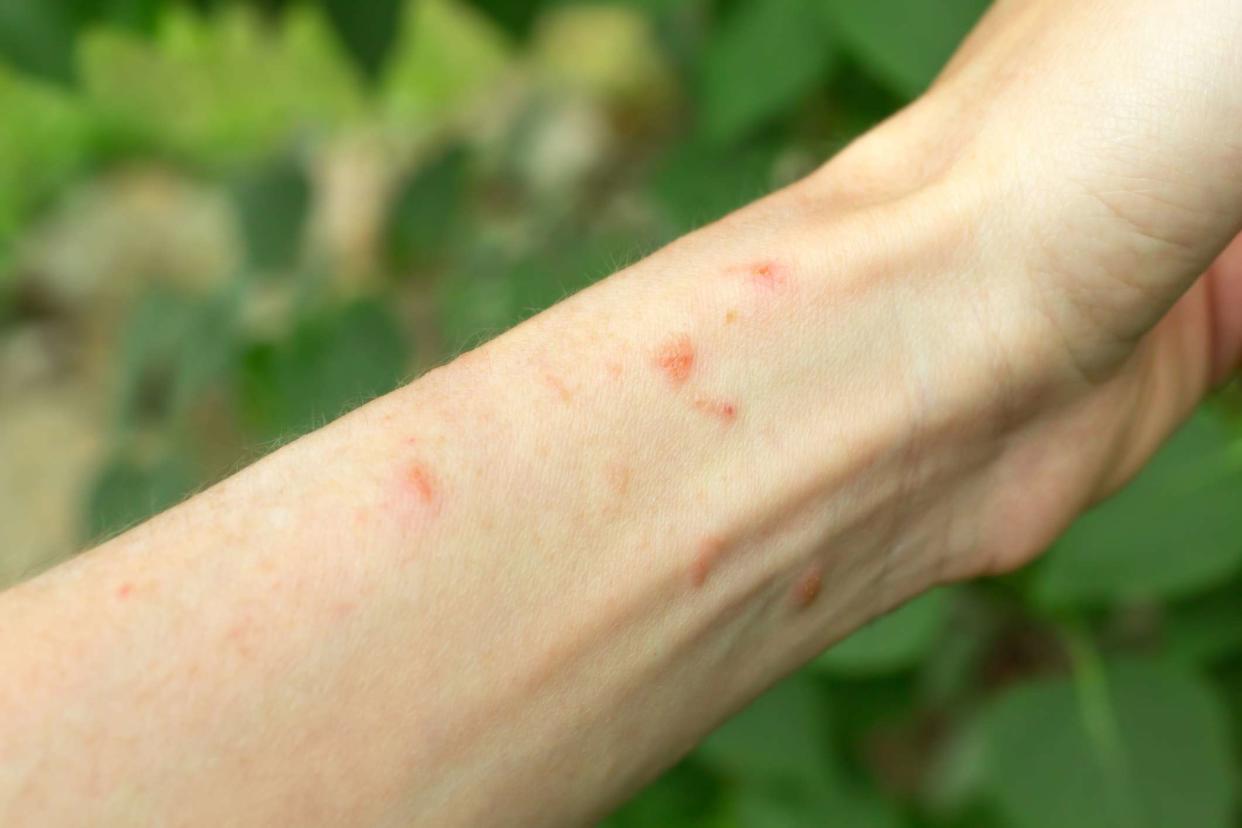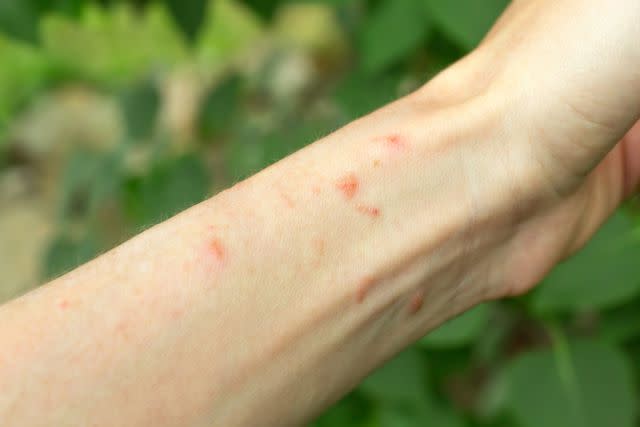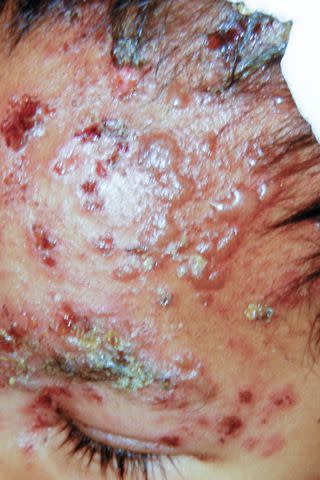How to Tell the Difference Between Shingles & Poison Ivy

Jena Ardell / Getty Images
Posion ivy rashMedically reviewed by Jane Kim, MD
Shingles and poison ivy can both cause a blistering rash that can look very similar, so you may wonder how to tell the difference. Even though the rashes look much the same, their causes, treatments, and prevention are different.
Although shingles and contact dermatitis from poison ivy both lead to small blisters, they are different in that shingles is very painful and the rash is limited to one part of the body. In contrast, the rash of poison ivy is incredibly itchy, with less pain, and can be found anywhere on the body.
This article discusses shingles and poison ivy rashes, focusing on symptoms and key differences.

Jena Ardell / Getty Images
Poison ivy rashShingles Rash vs. Poison Ivy Rash
Though these rashes can look similar, shingles and poison ivy rashes have some distinct differences.
Shingles
Shingles is a reactivation of the varicella-zoster virus that causes chickenpox. It is characterized by a painful rash that produces blisters on the skin. The area of skin can burn, tingle, or itch before the rash appears, but generally, shingles is known for producing a painful rash with blisters.
Typically, the rash shows up in a single area of the body—often on the torso—and creates a stripe or a band along the body. This line occurs because shingles is a viral rash that affects nerves under the skin.
Can Shingles Be Everywhere on the Body?
It is very rare for a person to have widespread shingles all over the body. This usually only occurs in people who are immunocompromised (having a weakened immune system, making them less able to fight off infections).
Poison Ivy
Poison ivy is a plant with leaves that contain an oil that causes an allergic reaction on the skin.
The poison ivy rash is a form of contact dermatitis. It occurs in areas of the skin where people are exposed to poison ivy.
A person can also spread the toxic oil from one part of the body to another by scratching. Therefore, the rash can appear anywhere on the body.
A poison ivy rash looks like small red bumps and blisters with skin swelling. It is incredibly itchy.
Other Plants Like Poison Ivy
Other plants also carry the same toxin as poison ivy, including poison oak and poison sumac.

Reproduced with permission from ©DermNet NZ www.dermnetnz.org 2022.
Additional Shingles Symptoms
One of the best ways to differentiate shingles from the poison ivy rash is by evaluating other associated symptoms. Since shingles is a viral rash, people will sometimes have other symptoms, such as:
Chills
Upset stomach
Body aches
Malaise (general feeling of being unwell)
In addition, people with shingles often have a burning pain under the skin before the rash appears.
Overall, shingles is more painful than poison ivy.
Complications of Shingles
People can develop complications with shingles, the most common being postherpetic neuralgia. Postherpetic neuralgia is chronic pain in the area of the rash.
Additional Poison Ivy Symptoms
While the poison ivy rash is incredibly itchy, it is not associated with other systemic symptoms. It is also not as painful as shingles.
Shingles and Poison Ivy Causes
Though they can present similarly, shingles and poison ivy have different causes.
Shingles
Shingles is caused by the varicella-zoster virus, the same virus that causes chickenpox.
As a baby or small child, you might have had chickenpox. The virus stays in your body throughout your lifetime and can reemerge when you are older as shingles.
Typically, people have only one episode of shingles in a lifetime. Triggers for reactivation include stress, infection, and certain medications.
Anyone who has had chickenpox can develop shingles, but it is most common in people over age 50. Other groups of people who are at higher risk of developing shingles include:
People with certain cancers
People who take immunosuppressive medications
People with immune system conditions like human immunodeficiency virus (HIV)
How Common Is Shingles?
According to the Centers for Disease Control and Prevention (CDC), one out of every three people will develop shingles at some point.
Poison Ivy
Anyone who works and plays in outdoor environments can develop poison ivy. The plant is found everywhere in the United States except in Alaska and Hawaii but is mainly found in the East and Midwest. Poison oak is common on the West Coast and southeastern United States, while poison sumac tends to grow in the eastern and southern states, in wet and wooded areas.
Often, people associate poison ivy with forests and trail areas, but it can even be found in your backyard.
Treatment
Shingles requires treatment with prescription antiviral medication and sometimes prescription pain medicine. If you think you have a shingles rash, you should see a healthcare provider right away.
Shingles Vaccination
An effective vaccine, Shingrix, is available to help prevent shingles. It is recommended for people age 50 and older.
People can manage contact dermatitis from poison ivy at home. Typically, treatments include:
Soothing calamine lotions and steroid creams like hydrocortisone
Oral antihistamines (e.g., Benadryl)
Placing cool compresses on the affected area
Though it will be difficult to avoid scratching the rash since it's so itchy, it's important to not scratch a poison ivy rash. Scratching can lead to infection.
When determining the cause of your rash, consider what other symptoms you have and whether you had any recent exposures. Also, remember that shingles is pretty painful.
If you are unsure about the cause of your rash, it is always wise to seek medical evaluation.
| Shingles | Rash of Poison Ivy |
Cause | Varicella-zoster virus (the same virus that causes chickenpox) | Contact with the oil on the leaves of the poison ivy plant (or poison oak or poison sumac) |
Characteristics | Painful, burning blisters that become ulcers in a band-like distribution | Itchy, red bumps and blisters anywhere on the body |
Symptoms | Chills, headache, body aches, upset stomach | Itchiness |
Treatment | Antiviral medication and pain medicine | Calamine lotion, oatmeal bath, hydrocortisone cream, oral antihistamine |
Prevention | Vaccination | Wearing long clothing in wooded areas |
Prevention
Your best chance at preventing shingles is to get vaccinated with the Shingrix vaccine. The Centers for Disease Control and Prevention (CDC) recommends that adults 50 years and older and adults 19 years and older who have weakened immune systems get two doses of the shingles vaccine. In adults, 50 to 69 years old, is 97% effective in preventing shingles and 91% effective in adults 70 years and older.
Ways to prevent contact with poison ivy include:
Learn to identify the plant. Each leaf has three glossy leaflets, with smooth or toothed edges. Leaves are reddish in spring, green in summer, and yellow, orange, or red in fall. They may have greenish-white flowers and whitish-yellow berries.
Avoid the plant. When hiking, stay on cleared paths. If camping, pitch your tent in a cleared area.
Wear protective clothing. Long sleeves, long pants tucked into boots, and impermeable gloves if gardening.
Wash your skin or pet's fur. If you've been exposed, wash your skin in soap and cool water as soon as possible to remove the resin and minimize the spread. If your pet may have brushed up against poison ivy, use pet shampoo and water while wearing rubber gloves to prevent spreading it.
Clean contaminated objects. Wash garden tools, gloves, clothing, jewelry, shoes, and other objects that may have come in contact with the resin in warm soapy water.
Summary
The rashes that result from shingles and poison ivy can look very similar, as they both lead to blisters on the skin. However, it's important to distinguish them since their treatment is very different.
Shingles is a painful rash usually in one area of the body. It often occurs in people over age 50 and has associated systemic symptoms. The rash of poison ivy (contact dermatitis) is very itchy and can occur in people of any age on any part of the body when the skin is exposed to the poison ivy plant.
Poison ivy can usually be treated at home without any major medical intervention. However, if you think you may have shingles, see your healthcare provider to discuss treatment options.

